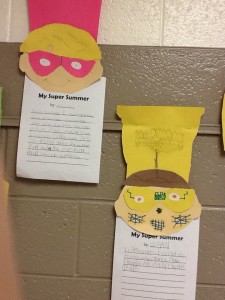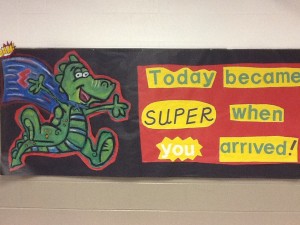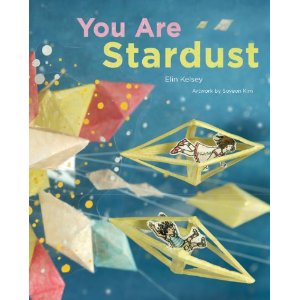A Piece of Cake
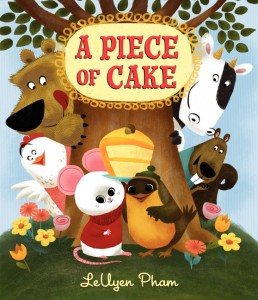 Every December I see lists of the best books of the year, and every year there’s at least one gem that I can’t believe isn’t getting more love. My choice this year for the “Don’t Miss This Picture Book” award is A Piece of Cake by LeUyen Pham (whose first name is pronounced “LeWin” but she mostly goes by “Win”. Now you know.)
Every December I see lists of the best books of the year, and every year there’s at least one gem that I can’t believe isn’t getting more love. My choice this year for the “Don’t Miss This Picture Book” award is A Piece of Cake by LeUyen Pham (whose first name is pronounced “LeWin” but she mostly goes by “Win”. Now you know.)
Pham had me from the moment she made the cover art reminiscent of a Golden Book, even down to her swirly signature. It starts like a sweet, simple story. A kind Mouse bakes a birthday cake for Little Bird, but then – there are all these unexpected surprises!
Mouse is bringing the cake to Little Bird’s house when Chicken stops him. Chicken wants a piece of cake, and the very kind Mouse has trouble saying no. Chicken, who is surrounded by eggs and is reading a book while sunning herself says, “If you give me a piece of that cake, I’ll trade you…” An egg, right? Nope! A cork, from Chicken’s bottle of suntan lotion.
At each stop on Mouse’s walk to and from Little Bird’s house, Pham sets us up to call out an obvious answer and then she delivers a twist that gets readers giggling. It reminds me of Guess Again by Mac Barnett and Adam Rex, but A Piece of Cake has a strong plot and internal logic as well as silly surprises. The cork that Chicken gave is used later for another unexpected purpose. It’s the ideal picture book to work on prediction and comprehension (Key Ideas and Details, anyone?)
Read this book aloud for the sheer pleasure of it, and then for the second reading, make a chart where kids can write what they thought would happen and what actually happened. “I thought Chicken would give Mouse ____ but then Chicken gave Mouse _________.” This is also a great story to act out for the whole group and then in centers so students can see what happens with each object. Make a Storybox with the characters and objects from the story for students to retell, and building comprehension skills will be A Piece of Cake.
Read More
Ling & Ting & Grace & Me!
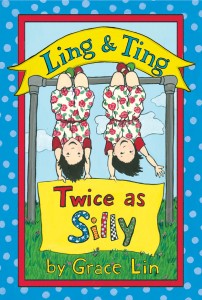 If you heard a loud, squeeing sound on November 11, that was me. I’m thrilled because the newest book in an early chapter book series I adore was just released: Ling & Ting: Twice as Silly by Grace Lin. I’m twice as excited about this book, because I wrote the Ling & Ting story starters that you can download and use with your students for FREE and it’s on Grace Lin’s website! My work on gracelin.com! I’m swooning to be linked with such a rock star!
If you heard a loud, squeeing sound on November 11, that was me. I’m thrilled because the newest book in an early chapter book series I adore was just released: Ling & Ting: Twice as Silly by Grace Lin. I’m twice as excited about this book, because I wrote the Ling & Ting story starters that you can download and use with your students for FREE and it’s on Grace Lin’s website! My work on gracelin.com! I’m swooning to be linked with such a rock star!
Grace Lin also has an exceptionally cool contest going on. Kiddos who are inspired to make up a silly story the way Ling and Ting do can receive a free Ling & Ting print and be entered to win a Pocket Pacy! The details are all available on Grace Lin’s blog.
Early chapter books like the Ling & Ting books are wonderful for building fluency. Each chapter is only a few pages long, so it’s easy to turn a chapter into a Readers’ Theater script. Also, you can work on comprehension skills (go, Key Ideas & Details and even Integrating Knowledge & Ideas if you compare two or more of the books) by making a Ling & Ting Venn diagram. Ling and Ting are twins, but we find out in their first book Ling & Ting: Not Exactly the Same that identical twins don’t have identical personalities. If you have twins in your classroom, they will be especially delighted to help point out the way the girls are different as well as the ways they are the same!
This month I’m presenting seminars in Oklahoma City, Dallas, Houston, Anaheim, and Pasadena. All in one week. I’ll be very thankful this Thanksgiving to be done traveling for 2014. As I count my blessings, I’ll also give thanks for you, for letting me share my passion for kids’ books with you.
P.S. Thanks Curious City for connecting me with Grace Lin. I’m still grinning!
Read MoreTen Rules of Being a Superhero
 I’ll bet you a sack of Halloween candy that most of us have dreamed of being a superhero: saving the day, maybe flying, definitely wearing a cool cape and a mask. Snazzy accessories aside, if you want to be a superhero, you need this book: Ten Rules of Being a Superhero by Deb Pilutti.
I’ll bet you a sack of Halloween candy that most of us have dreamed of being a superhero: saving the day, maybe flying, definitely wearing a cool cape and a mask. Snazzy accessories aside, if you want to be a superhero, you need this book: Ten Rules of Being a Superhero by Deb Pilutti.
Captain Magma and Lava Boy show us the rules with bright, captivating art and with short sentences to support younger readers. Big ideas like courage, integrity, and loyalty are introduced in kid-friendly ways, and there are good giggles, too. For example, Rule Number 2: “Saving the day is messy.” As Lava Boy cleans up the playroom ( with Captain Magma holding the dustpan), he adds, “Moms don’t understand Rule Number 2.”
There’s a fantastic, free discussion and activity guide (written by Superteacher Debbie Gonzales) that you can print from debpilutti.com. You’ll find fun games and a story sequencing activity that nails that Key Ideas & Details reading standard. I think Ten Rules of Being a Superhero makes a wonderful discussion and writing prompt. What are the qualities of a superhero? Who can be one? Since it’s October and many kids are thinking about costumes anyway, what about making superhero gear? Towels and blankets from the thrift store (thoroughly washed) can be made into capes. Donated t-shirts or paper grocery bags can be decorated with paints and markers.
One of my favorite elementary schools kicked off the year with this theme “Our School: Where Superheroes Are Made”. I’m sharing some photos that might inspire some super ideas. Read Ten Rules of Being a Superhero by Deb Pilutti to your students and watch how it pulls in your students like metal to Magneto.
Read MoreMoo!
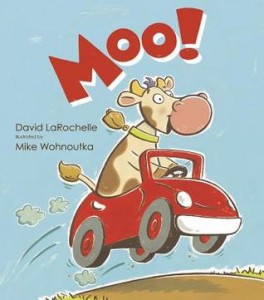 It’s the beginning of a new school year and we want all our students to start off feeling successful. If you have kids that are beginning or struggling readers, here is a book that almost everyone will be able to read confidently: Moo! written by David LaRochelle and illustrated by Mike Wohnoutka.
It’s the beginning of a new school year and we want all our students to start off feeling successful. If you have kids that are beginning or struggling readers, here is a book that almost everyone will be able to read confidently: Moo! written by David LaRochelle and illustrated by Mike Wohnoutka.
This is no boring “baby book”. The humor of this one works for a wide range of kids, especially if you model reading it aloud with great expression. I read this one for an all-ages Stories in the Park event this summer and even the grown-ups were chuckling. Even though the book consists almost entirely of one word, the punctuation, the text formatting, and the pictures determine how the word is read. So not only is it a bull’s-eye for the Core Standard of Fluency, it works beautifully into a lesson on punctuation and Print Concepts.
Read Moo! aloud to your students and, once the giggles die down, talk about how you knew how to read the same word differently. For example, look at this page from the book:  There are moos in italics, in bold font, in all capitals and these differences, along with the punctuation, help determine how to read this page. Share the book again, asking different students to use the text and picture clues to help them read the page with feeling. Now you’ve got a lead-in to a great writing exercise. Brainstorm two lists: a list of punctuation and text styles that were used to change the meaning of “moo” so many times, and a list of animals that make a sound. Kids can write and draw about an animal that goes off on an adventure (using punctuation and formatting to show meaning) and they’ll only have to worry about spelling one word. Fun!
There are moos in italics, in bold font, in all capitals and these differences, along with the punctuation, help determine how to read this page. Share the book again, asking different students to use the text and picture clues to help them read the page with feeling. Now you’ve got a lead-in to a great writing exercise. Brainstorm two lists: a list of punctuation and text styles that were used to change the meaning of “moo” so many times, and a list of animals that make a sound. Kids can write and draw about an animal that goes off on an adventure (using punctuation and formatting to show meaning) and they’ll only have to worry about spelling one word. Fun!
I Pledge Allegiance
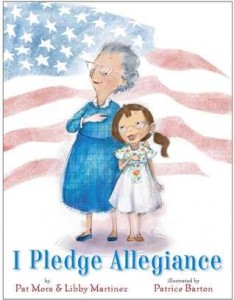 Happy August! Although summer is in full swing in Michigan, one of my local elementary schools is already back in session. Whether your school bell has tolled or you have one more glorious month to enjoy, you’ll want to have this beautiful book in your classroom: I Pledge Allegiance by Pat Mora & Libby Martinez and illustrated by Patrice Barton.
Happy August! Although summer is in full swing in Michigan, one of my local elementary schools is already back in session. Whether your school bell has tolled or you have one more glorious month to enjoy, you’ll want to have this beautiful book in your classroom: I Pledge Allegiance by Pat Mora & Libby Martinez and illustrated by Patrice Barton.
Libby’s great-aunt Lobo is becoming a citizen of the United States. Her story gives a meaningful framework for the information shared about the Pledge of Allegiance. We learn a bit of history about the Pledge and what it means when we say things like “allegiance” and “indivisible”. The entire Pledge is in the text several times, so kids will be able to recite along. The soft art that celebrates our country’s diversity and the sprinkling of Spanish words (Libby’s great-aunt is from Mexico) are wonderful inclusions.
Not only is this book a fantastic story about the immigration experience, it’s the perfect springboard for a lesson on what we are really saying when we recite the Pledge of Allegiance. For example, Lobo tells Libby, “‘I like the words “liberty and justice for all… we are promising to be fair to everyone.'” Write the Pledge of Allegiance on a chart and put it next to a large open space on a whiteboard. Using I Pledge Allegiance as a guide, students can help translate the lines of the Pledge into terms that make sense to them. It’s a great vocabulary lesson (so you can check off Craft & Structure on your Common Core to-do list) and it will make the Pledge of Allegiance much more meaningful and personal for your students. This is patriotism at its best.
Read More
Nerd Camp and Twitter
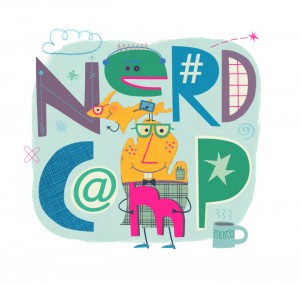 Yesterday I attended nErD Camp, a free, education “unconference” presented by the Nerdy Book Club. For a day and a half, teachers from all over the states came to Parma, Michigan to share ideas about literacy and learning. I led a small session about using public libraries to get kids and teachers the materials they need year-round. I joined sessions on using graphic novels and picture books at all levels and on using Google Docs with forms and add-ins to organize kids’ writing and promote collaboration. (Email me if you want details.)
Yesterday I attended nErD Camp, a free, education “unconference” presented by the Nerdy Book Club. For a day and a half, teachers from all over the states came to Parma, Michigan to share ideas about literacy and learning. I led a small session about using public libraries to get kids and teachers the materials they need year-round. I joined sessions on using graphic novels and picture books at all levels and on using Google Docs with forms and add-ins to organize kids’ writing and promote collaboration. (Email me if you want details.)
Nerd Camp, Jr. was in the evening. Hundreds of kids got to meet authors and illustrators, talk about reading and writing, and score free books. Matt Faulkner, Ruth McNally Barshaw, Linda Urban, Laurie Keller, and others wowed the crowd. (Laurie Keller designed the Nerd Camp logo. Isn’t it fantastic?)
My brain is spinning with new ideas and my appreciation for teachers is even greater than it was before. In July, when most teachers are finally able to enjoy a break, these folks came for a professional development event and generously shared what they knew. I am inspired by you all. Thanks to Colby and Alainna Sharp, Donalyn Miller, Kristin McIlhagga, and the entire Nerdy Book Club powerhouse. nErD Camp 2015 is already in the works if you want in on the fun.
And thank you, Nerds, for pulling me into the world of Twitter! You can follow me @RemenarReads. I promise to tweet only about literacy and books (saving my crazy cat photos for Facebook).
Read MoreYou Are Stardust
Happy July! This is the month for fireworks and stargazing and wonder, which makes it the perfect month for You Are Stardust written by Elin Kelsey with artwork by Soyeon Kim. It begins like this:
“You are stardust./
Every tiny atom in your body came from a star that exploded long before you were born.”
This informational science book reads like poetry, and the facts within will astound your students:
We breathe in more than a million pollen grains with each breath.
The water we drink today is the same water that filled puddles when dinosaurs walked the Earth.
The electricity in your brain is stronger than lightning.
On owlkidsbooks.com, you’ll find a free teacher’s guide, a link to the app, a video showing second graders discussing the book’s themes, and a video that I found fascinating on how the book was made. Soyeon Kim’s dioramas are awesome and will inspire your kids to get out the art supplies. Choose an incredible fact from the book or one from the world that amazes you and bring it to life with a 3-D diorama. You might even ask a friendly librarian at your local library to put your diorama on display. (I know I’d say yes!) I hope that you and your students can be awed like Elin Kelsey and Soyeon Kim were and find beauty in our connections to the natural world.
Read More




